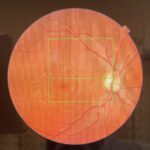
28 Jan Understanding the Link Between High Cholesterol and Retinal Health: The Role of Drusen in Your Eyesight
As we age, our bodies undergo various changes, and so do our eyes. One such change is the formation of drusen, tiny yellow or white deposits under the retina. Interestingly, recent research indicates a correlation between high blood cholesterol levels and the formation of these drusen, shedding light on how our dietary choices and health can affect our vision.
What are Drusen?
Drusen are small, lipid-rich deposits that form beneath the retina. They are often associated with age-related macular degeneration (AMD), a leading cause of vision loss in older adults. While a few small drusen may not cause problems, larger and more numerous drusen increase the risk of developing advanced AMD.
The Cholesterol Connection
High blood cholesterol is a well-known risk factor for heart disease, but its impact on eye health is less widely recognised. Cholesterol can accumulate in blood vessels throughout the body, including those in the eyes. This buildup can affect blood flow and lead to inflammation, contributing to the formation of drusen and the progression of AMD.
Risk Factors for High Cholesterol and AMD:
- Age: The risk increases as you get older.
- Diet: High intake of saturated fats and cholesterol-rich foods.
- Lifestyle: Smoking and lack of exercise.
- Genetics: Family history of high cholesterol or AMD.
- Medical conditions: Diabetes, high blood pressure, and obesity.
Dietary Advice for Healthy Eyes and Heart
A heart-healthy diet is also beneficial for your eyes. Here are some tips:
- Fruits and Vegetables: Rich in antioxidants, they help combat damage caused by inflammation.
- Whole Grains: They help manage cholesterol levels.
- Healthy Fats: Omega-3 fatty acids, found in fish, are particularly good for retinal health.
- Nuts and Legumes: These are great sources of protein and healthy fats.
- Limit Saturated Fats and Cholesterol: Reducing intake of high-fat meats, full-fat dairy products, and processed foods can help lower cholesterol levels.
Signs and Symptoms to Watch Out For
Regular eye exams are crucial, as early stages of AMD often have no symptoms. However, as the condition progresses, some signs may appear:
- Blurred or distorted vision.
- Difficulty adapting to low light.
- Impaired colour perception.
- A dark or empty area in the centre of vision.
The Importance of Regular Eye Exams
For those with high cholesterol, or risk factors for AMD, regular eye exams are essential. An optometrist can detect early signs of drusen formation and monitor any changes in the retina. These exams become increasingly important as you age, especially if you have a family history of AMD or cardiovascular diseases.
Conclusion
The link between high cholesterol and the formation of drusen is a reminder of how interconnected our overall health is with our eye health. By managing cholesterol through diet, lifestyle changes, and medication when necessary, we can help protect our vision. Remember, proactive measures and regular eye exams play a pivotal role in maintaining both your visual and overall health. Perhaps consider a supplement like Nutrof Total if you have been identified has having early retinal drusen and your diet/life style are not optimising your health.
